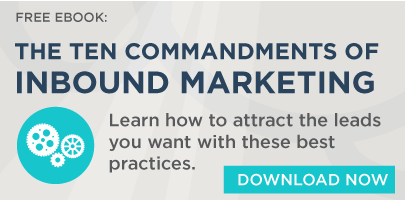Inbound Marketing Commandment #7: Thou Shalt Create Lead Generation Materials
As part of the LeadG2 series on "The 10 Commandments of Inbound Marketing" we're looking at each of these ten commandments and the importance of each...
3 min read
 LeadG2
:
October 17, 2016
LeadG2
:
October 17, 2016


As part of the LeadG2 series on "The 10 Commandments of Inbound Marketing" we will be discussing each of these ten commandments and the importance of each one. Also, we will be discussing why these principles are ones that you can’t ignore. The third of The 10 Commandments of Inbound Marketing is: Your website must be mobile optimized or responsive. (Tweet This)
Okay, it’s 2016 and I am going to take a leap of faith and assume that your company has a “modern” website that’s been updated in the past few years and includes more than just pictures and descriptions of your products and services. If so, that’s a great start. An even better next step, if you don’t already have one, is adding a blog and making sure that you have plenty of calls-to-action that help generate leads and get visitors to become customers.
Assuming you already have a website that has a blog and you are getting a few leads, the next thing to absolutely make sure you have in place is a website that is either mobile-optimized or responsive.
The reason why companies need to have a mobile-friendly site is that last year, Google made an announcement that the latest update to its search algorithm will favor sites that are mobile-optimized. This means that sites that are not optimized for mobile will be missing out on lots of potential traffic and possibly surrendering that traffic to a competitor’s mobile-optimized site.
If you want to to know how mobile-friendly your website is, you can use the Google Developers Mobile-Friendly Test.
It’s time to get slightly technical for a few minutes—there is a difference between a mobile-optimized and a responsive website, and it’s important to know the difference.
A mobile-optimized site will detect what type of mobile device you have and reconfigure the content to look great on any mobile browser or tablet. Typically, a mobile-optimized site has its own navigation that’s easier to use on a mobile device, larger buttons, and calls-to-action and images that render faster or not at all to increase speed. The mobile-optimized site also tends to stack the content rather than spread it out horizontally. The website is basically optimized to look good on any mobile device. One possible downside to a mobile-optimized site is that the optimized site sometimes exists on a separate subdomain, such as m.yourdomain.com or mobile.yourdomain.com.
A responsive website, on the other hand, is a site that not only looks great on mobile but a desktop as well. While you are browsing you are able to size different content areas and it changes based on the way you move your device. For instance, if you have an iPad and you are viewing the responsive site, it will allow you to zoom and make the site larger or smaller and allow you to zoom in and zoom out by using your fingers. A responsive site can also incorporate different menus and navigation based on the size of the screen/device that you are on, which gives it functionality similar to a mobile-optimized site.
Website developers typically recommend responsive websites over a mobile-optimized site. The reason for this is because responsive sites offer a much better user experience and offer developers much more creative options when developing a site.
Regardless of if your site is mobile optimized or responsive, the key is that you have taken this important step to making sure your website has the best user experience and shows up as high as it can in search rankings.
Make sure to subscribe to the LeadG2 blog to get each of The 10 Commandments of Inbound Marketing and other great blog content delivered to your inbox. Or you can download The 10 Commandments of Inbound Marketing, which includes all 10 of the blog posts and some added content.


As part of the LeadG2 series on "The 10 Commandments of Inbound Marketing" we're looking at each of these ten commandments and the importance of each...

As part of the LeadG2 series on "The 10 Commandments of Inbound Marketing" we are discussing each of these ten commandments and the importance of...

As part of the LeadG2 series on "The 10 Commandments of Inbound Marketing" we will be discussing each of these 10 commandments and the importance of...